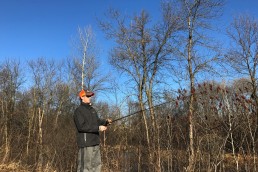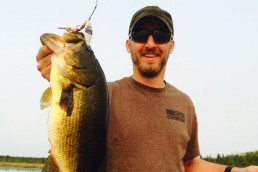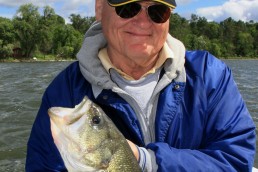Fighting Fishing Fatigue and Lost Fish: Selecting a rod to solve both problems
SHARE THIS POST
Fishermen purchase rods for many reasons—some choose ones for a specific need while others buy one because the price is right and it’s too hard to pass up. While there is nothing wrong with doing the latter, it’s likely that discounted fishing rod is designed for only one or two fishing techniques.
Now you may say that a rod is rod and it will work in a variety of situations. This may be true, but sometimes there are scenarios when using an incorrect rod for a specific presentation can result in missed or lost fish and even a possible injury or fatigue to you the angler. Using the proper rod depends on several variables: what bait you’re fishing, type of line and gear ratio of reel. By taking all of these into account you’ll then be able to put together the proper rod setup to increase the number of bass that cross the gunwale.
Adam Trieschmann owns Witch Doctor Tackle and is also a rod builder. He has spent years developing the Witch Doctor Tackle lineup of rods. He went over a scenario with me that he recently faced on the water. That day, he said he only had one rod with him—a 7 foot 6 inch, medium-heavy casting rod with 30-pound-test braided line spooled on the reel. His initial lure offering was a lipless crankbait, and the result was one of the three bass that made it into the boat. The one that did was hooked outside the mouth because the rod had no give, coupled with fact that there was no stretch in the braided line. The bass literally weren’t getting the opportunity to get the bait in their mouths.
Next on the docket he said was a 1/2-ounce spinnerbait. The result was the same; again, the wrong rod was used. The last offering was to try a 1/4-ounce, Texas-rigged soft plastic craw. Finally, success—every single bass that hit the bait was caught and landed. Now, Adam could’ve changed up his line selection to monofilament or used a lower-gear-ratio reel for the first two presentations and his success could’ve increased some. But the primary element in the equation was that the incorrect rod was used first. Select the proper rod and you’ll hook-up and land more bass.
When it comes to flipping, pitching and especially punching mats or heavy vegetation with a heavy tungsten weight Texas-rig or jig, it’s paramount that you use a rod that isn’t too lite.
“If you pair up too lite of a rod with a heavy weighted lure, you’ll absolutely wear yourself out,” Trieschmann says. “By using the right weight of rod for flipping in these situations, you’ll be using the strongest muscle in your arm to do the work—your bicep—instead of your wrist.”
The scenario above is how many anglers will develop tennis elbow or bursitis in their shoulder. Years of flipping with a rod that is too light can result in the rod tip wanting to always be up. By using the right rod for these situations, such as the Oracle from Witch Doctor Tackle, the rod will want to go down, which I turn will naturally “pendulum” your bait to the target. By practicing this technique, you’ll then be able to flip farther and impart a more natural action with your bait.
Are you enjoying this post?
You can be among the first to get the latest info on where to go, what to use and how to use it!
Another benefit to using a rod with the correct action for heavy cover is when your jig or Texas rig gets hung up on a reed or weed clump, it won’t sling-shot it back at you as it would while using too light a rod. For example, the Hydrilla Gorilla will load up on a 2-pound bass, but the tip is stiff enough so it won’t load up when bait is hung up on a reed. This eliminates the safety hazard of a heavier tungsten sinker and sharp hook flying toward your face.
If you have spent time casting small baits that don’t weight much, you know that it can be tiresome to put all your effort into casting a number 5 or 7 Rapala Shad Rap a great distance, especially if the wind is blowing into you. By using a rod that isn’t designed for these small baits, you will be fatiguing yourself cast after cast, and by the end of the day you will be physically drained and setting yourself up for shoulder aliments. By using a medium-action rod, you’ll be able to cast that Shad Rap or balsa crankbait farther, meaning you can cover more water in a shorter amount of time and can fish that presentation all day without feeling tired or feel the need to take a break to let your shoulder rest. For me, the Witch Doctor Tackle Surman50G Medium-action 6 foot 10 inch casting rod is the tool. With this rod, I can whip a Shad Rap all day long for early-season bass action.
As you upgrade your rods or add to your arsenal this season, take the time to think about the exact presentation you’ll be using. You want that rod to be designed and built for a specific presentation. By using the right rod you can increase your fishing success and keep yourself casting and farther and fishing longer periods without feeling fatigued.
When buying a rod
Perks of a longer rod: This depends on the type fishing. If you’re making longer casts, you need a longer rod to pick up more slack in your line prior to setting the hook. Using longer rods also aid in making longer casts with monofilament line. If you’re fishing shallow water or want to keep your baits up in the water column and above submerged vegetation, a longer rod will bring your lure up in the water column.
Butt length: When selecting a fishing rod, pay attention to the butt length. A longer, typical 11-inch butt, allows you to get two hands on it, resulting in more leverage to make longer casts. A rod with a short butt (9 inches) is good in tight quarters to make pinpoint casts when using a lighter-action rod.
Casting light lures: If you’re casting small lures that don’t weigh much, you’ll want to use a slower-action rod so you can cast the lure farther out.
MWO
SHARE THIS POST
Did you enjoy this post?
You can be among the first to get the latest info on where to go, what to use and how to use it!
Glenn Walker
Glenn Walker has been fishing Minnesota and Mississippi River tournaments for more than 15 years, spreading his passion and knowledge of the sport via articles and videos. For more information, check out glennwalkerfishing.com or on Facebook @GlennWalkerFishing.



